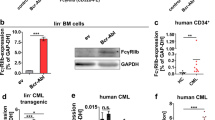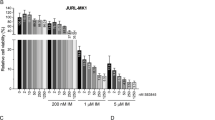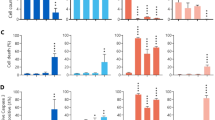Abstract
High cancerous inhibitor of PP2A (CIP2A) protein levels at diagnosis of chronic myeloid leukaemia (CML) are predictive of disease progression in imatinib-treated patients. It is not known whether this is true in patients treated with second generation tyrosine kinase inhibitors (2G TKI) from diagnosis, and whether 2G TKIs modulate the CIP2A pathway. Here, we show that patients with high diagnostic CIP2A levels who receive a 2G TKI do not progress, unlike those treated with imatinib (P=<0.0001). 2G TKIs induce more potent suppression of CIP2A and c-Myc than imatinib. The transcription factor E2F1 is elevated in high CIP2A patients and following 1 month of in vivo treatment 2G TKIs suppress E2F1 and reduce CIP2A; these effects are not seen with imatinib. Silencing of CIP2A, c-Myc or E2F1 in K562 cells or CML CD34+ cells reactivates PP2A leading to BCR-ABL suppression. CIP2A increases proliferation and this is only reduced by 2G TKIs. Patients with high CIP2A levels should be offered 2G TKI treatment in preference to imatinib. 2G TKIs disrupt the CIP2A/c-Myc/E2F1 positive feedback loop, leading to lower disease progression risk. The data supports the view that CIP2A inhibits PP2Ac, stabilising E2F1, creating a CIP2A/c-Myc/E2F1 positive feedback loop, which imatinib cannot overcome.
This is a preview of subscription content, access via your institution
Access options
Subscribe to this journal
Receive 12 print issues and online access
$259.00 per year
only $21.58 per issue
Buy this article
- Purchase on Springer Link
- Instant access to full article PDF
Prices may be subject to local taxes which are calculated during checkout






Similar content being viewed by others
References
Ben-Neriah Y, Daley GQ, Mes-Masson AM, Witte ON, Baltimore D . The chronic myelogenous leukemia-specific p210 protein is the product of the BCR/ABL hybrid gene. Science 1986; 233: 212–214.
Lucas CM, Wang L, Austin GM, Knight K, Watmough SJ, Shwe KH et al. A population study of imatinib in chronic myeloid leukaemia demonstrates lower efficacy than in clinical trials. Leukemia 2008; 22: 1963–1966.
de Lavallade H, Apperley JF, Khorashad JS, Milojkovic D, Reid AG, Bua M et al. Imatinib for newly diagnosed patients with chronic myeloid leukemia: incidence of sustained responses in an intention-to-treat analysis. J Clin Oncol 2008; 26: 3358–3363.
Neviani P, Santhanam R, Trotta R, Notari M, Blaser BW, Liu S et al. The tumor suppressor PP2A is functionally inactivated in blast crisis CML through the inhibitory activity of the BCR/ABL-regulated SET protein. Cancer Cell 2005; 8: 355–368.
Lucas CM, Harris RJ, Giannoudis A, Copland M, Slupsky JR, Clark RE . Cancerous inhibitor of PP2A (CIP2A) at diagnosis of chronic myeloid leukaemia is a critical determinant of disease progression. Blood 2011; 117: 6660–6668.
Côme C, Laine A, Chanrion M, Edgren 4H, Mattila E, Liu X et al. CIP2A Is associated with human breast cancer aggressivity. Clin Cancer Res 2009; 15: 5092–5100.
Junttila MR, Puustinen P, Niemela M, Ahola R, Arnold H, Bottzauw T et al. CIP2A inhibits PP2A in human malignancies. Cell 2007; 130: 51–62.
Laine A, Sihto H, Come C, Rosenfeldt MT, Zwolinska A, Niemela M et al. Senescence sensitivity of breast cancer cells is defined by positive feedback loop between CIP2A and E2F1. Cancer Discov 2013; 3: 182–197.
Khanna A, Bockelman C, Hemmes A, Junttila MR, Wiksten JP, Lundin M et al. MYC-dependent regulation and prognostic role of CIP2A in gastric cancer. J Nati Cancer Inst 2009; 101: 793–805.
Ma L, Wen Z, Liu Z, Hu Z, Ma J, Chen X-Q et al. Overexpression and small molecule-triggered downregulation of CIP2A in lung cancer. PLoS One 2011; 6: e20159.
Mathiasen DP, Egebjerg C, Andersen SH, Rafn B, Puustinen P, Khanna A et al. Identification of a c-Jun N-terminal kinase-2-dependent signal amplification cascade that regulates c-Myc levels in ras transformation. Oncogene 2012; 31: 390–401.
Wang J, Li W, Li L, Yu X, Jia J, Chen C . CIP2A is over-expressed in acute myeloid leukaemia and associated with HL60 cells proliferation and differentiation. Int J Lab Hematol 2011; 33: 290–298.
Yu G, Liu G, Dong J, Jin Y . Clinical implications of CIP2A protein expression in breast cancer. Med Oncol 2013; 30: 013–0524.
Tseng LM, Liu CY, Chang KC, Chu PY, Shiau CW, Chen KF . CIP2A is a target of bortezomib in human triple negative breast cancer cells. Breast Cancer Res 2012; 14: R68.
Niemela M, Kauko O, Sihto H, Mpindi J, Nicorici D, Pernila P et al. CIP2A signature reveals the MYC dependency of CIP2A-regulated phenotypes and its clinical association with breast cancer subtypes. Oncogene 2012; 31: 4266–4278.
Huang LP, Savoly D, Sidi AA, Adelson ME, Mordechai E, Trama JP . CIP2A protein expression in high-grade, high-stage bladder cancer. Cancer Med 2012; 1: 76–81.
Pallai R, Bhaskar A, Sodi V, Rice LM . Ets1 and Elk1 transcription factors regulate cancerous inhibitor of protein phosphatase 2A expression in cervical and endometrial carcinoma cells. Transcription 2012; 3: 6.
Huang LP, Adelson ME, Mordechai E, Trama JP . CIP2A expression is elevated in cervical cancer. Cancer Biomark 2010; 8: 309–317.
He H, Wu G, Li W, Cao Y, Liu Y . CIP2A is highly expressed in hepatocellular carcinoma and predicts poor prognosis. Diagn Mol Pathol 2012; 21: 143–149.
Sung WW, Wang YC, Lin PL, Cheng YW, Chen CY, Wu TC et al. IL-10 promotes tumor aggressiveness via upregulation of CIP2A transcription in lung adenocarcinoma. Clin Cancer Res 2013; 6: 6.
Dong Q-Z, Wang Y, Dong X-J, Li Z-X, Tang Z-P, Cui Q-Z et al. CIP2A is overexpressed in non-small cell lung cancer and correlates with poor prognosis. Ann Surg Oncol 2011; 18: 857–865.
Mukhopadhyay A, Saddoughi SA, Song P, Sultan I, Ponnusamy S, Senkal CE et al. Direct interaction between the inhibitor 2 and ceramide via sphingolipid-protein binding is involved in the regulation of protein phosphatase 2A activity and signaling. FASEB j 2009; 23: 751–763.
Sawyers CL, Callahan W, Witte ON . Dominant negative MYC blocks transformation by ABL oncogenes. Cell 1992; 70: 901–910.
Strnad M, Brajusković G, Strelić N, Zivanović BT, Tukić L, Stamatović D . Expression of Bcl-2 protein and the amplification of c-myc gene in patients with chronic myeloid leukemia. Vojnosanit Pregl 2006; 63: 364–369.
Prochownik EV, Li Y . The ever expanding role for c-Myc in promoting genomic instability. Cell Cycle 2007; 6: 1024–1029.
Oudat R, Khan Z, Glassman AB . Detection of trisomy 8 in philadelphia chromosome-positive CML patients using conventional cytogenetic and interphase fluorescence in situ hybridization techniques and its relation to c-myc involvement. Ann Clin Lab Sci 2001; 31: 68–74.
Mohty M, Yong ASM, Szydlo RM, Apperley JF, Melo JV . The polycomb group BMI1 gene is a molecular marker for predicting prognosis of chronic myeloid leukemia. Blood 2007; 110: 380–383.
Engelmann D, Pützer BM . The dark side of E2F1: in transit beyond apoptosis. Cancer Res 2012; 72: 571–575.
Stewart MJ, Litz-Jackson S, Burgess GS, Williamson EA, Leibowitz DS, Boswell HS . Role for E2F1 in p210 BCR-ABL downstream regulation of c-myc transcription initiation. Studies in murine myeloid cells. Leukemia 1995; 9: 1499–1507.
Singh P, Wong SH, Hong W . Overexpression of E2F-1 in rat embryo fibroblasts leads to neoplastic transformation. EMBO J 1994; 13: 3329–3338.
Tsai S-Y, Opavsky R, Sharma N, Wu L, Naidu S, Nolan E et al. Mouse development with a single E2F activator. Nature 2008; 454: 1137–1141.
Mundle SD, Saberwal G . Evolving intricacies and implications of E2F1 regulation. FASEB J 2003; 17: 569–574.
Polager S, Ginsberg D . p53 and E2f: partners in life and death. Nat Rev Cancer 2009; 9: 738–748.
Larson RA, Hochhaus A, Hughes TP, Clark RE, Etienne G, Kim DW et al. Nilotinib vs imatinib in patients with newly diagnosed Philadelphia chromosome-positive chronic myeloid leukemia in chronic phase: ENESTnd 3-year follow-up. Leukemia 2012; 26: 2197–2203.
Kantarjian HM, Shah NP, Cortes JE, Baccarani M, Agarwal MB, Undurraga MS et al. Dasatinib or imatinib in newly diagnosed chronic-phase chronic myeloid leukemia: 2-year follow-up from a randomized phase 3 trial (DASISION). Blood 2012; 119: 1123–1129.
Lucas CM, Harris RJ, Giannoudis A, Knight K, Watmough SJ, Clark RE . BCR-ABL1 tyrosine kinase activity at diagnosis, as determined via the pCrkL/CrkL ratio, is predictive of clinical outcome in chronic myeloid leukaemia. Br J Haematol 2010; 149: 458–460.
Wang L, Pearson K, Ferguson JE, Clark RE . The early molecular response to imatinib predicts cytogenetic and clinical outcome in chronic myeloid leukaemia. Br J Haematol 2003; 120: 990–999.
Marin D, Ibrahim AR, Lucas C, Gerrard G, Wang L, Szydlo RM et al. Assessment of BCR-ABL1 transcript levels at 3 months is the only requirement for predicting outcome for patients with chronic myeloid leukemia treated with tyrosine kinase inhibitors. J Clin Oncol 2012; 30: 232–238.
Neelakantan P, Gerrard G, Lucas C, Milojkovic D, May P, Wang L et al. Combining BCR-ABL1 transcript levels at 3 and 6 months in chronic myeloid leukemia: implications for early intervention strategies. Blood 2013; 121: 2739–2742.
Hamilton A, Elrick L, Myssina S, Copland M, Jorgensen H, Melo JV et al. BCR-ABL activity and its response to drugs can be determined in CD34+ CML stem cells by CrkL phosphorylation status using flow cytometry. Leukemia 2006; 20: 1035–1039.
White DL, Saunders V, Lyons AB, Branford S, Grigg A, To LB et al. In vitro sensitivity to imatinib-induced inhibition of ABL kinase activity is predictive of molecular response in patients with de novo CML. Blood 2005; 106: 2520–2526.
Calabretta B, Perrotti D . The biology of CML blast crisis. Blood 2004; 103: 4010–4022.
Feinstein E, Cimino G, Gale RP, Alimena G, Berthier R, Kishi K et al. p53 in chronic myelogenous leukemia in acute phase. Proc Natl Acad Sci USA 1991; 88: 6293–6297.
Ahuja H, Bar-Eli M, Advani SH, Benchimol S, Cline MJ . Alterations in the p53 gene and the clonal evolution of the blast crisis of chronic myelocytic leukemia. PNAS 1989; 86: 6783–6787.
Neviani P, Santhanam R, Oaks J, Eiring A, Notari M, Blaser B et al. FTY720, a new alternative for treating blast crisis chronic myelogenous leukemia and Philadelphia chromosome-positive acute lymphocytic leukemia. J Clin Invest 2007; 117: 2408–2421.
Saddoughi SA, Gencer S, Peterson YK, Ward KE, Mukhopadhyay A, Oaks J et al. Sphingosine analogue drug FTY720 targets I2PP2A/SET and mediates lung tumour suppression via activation of PP2A-RIPK1-dependent necroptosis. EMBO Mol Med 2013; 5: 105–121.
Neviani P, Harb JG, Oaks JJ, Santhanam R, Walker CJ, Ellis JJ et al. PP2A-activating drugs selectively eradicate TKI-resistant chronic myeloid leukemic stem cells. J Clin Invest 2013; 123: 4144–4157.
Kerosuo L, Fox H, Perälä N, Ahlqvist K, Suomalainen A, Westermarck J et al. CIP2A increases self-renewal and is linked to Myc in neural progenitor cells. Differentiation 2010; 80: 68–77.
Amin HM, Hoshino K, Yang H, Lin Q, Lai R, Garcia-Manero G . Decreased expression level of SH2 domain-containing protein tyrosine phosphatase-1 (Shp1) is associated with progression of chronic myeloid leukaemia. J Pathol 2007; 212: 402–410.
Birchenall-Roberts MC, Yoo YD, Bertolette DC 3rd, Lee KH, Turley JM, Bang OS et al. The p120-v-Abl protein interacts with E2F-1 and regulates E2F-1 transcriptional activity. J Biol Chem 1997; 272: 8905–8911.
Eiring AM, Neviani P, Santhanam R, Oaks JJ, Chang JS, Notari M et al. Identification of novel posttranscriptional targets of the BCR/ABL oncoprotein by ribonomics: requirement of E2F3 for BCR/ABL leukemogenesis. Blood 2008; 111: 816–828.
Bilousova G, Marusyk A, Porter CC, Cardiff RD, DeGregori J . Impaired DNA replication within progenitor cell pools promotes leukemogenesis. PLoS Biol 2005; 3: e401.
Lucas CM, Harris RJ, Giannoudis A, Clark RE . c-Myc inhibition decreases CIP2A and reduces BCR-ABL1 tyrosine kinase activity in chronic myeloid leukemia. Haematologica 2015; e-pub ahead of print 6 February 2015.
Jeong AL, Lee S, Park JS, Han S, Jang C-Y, Lim J-S et al. Cancerous Inhibitor of Protein Phosphatase 2A (CIP2A) Protein Is Involved in Centrosome Separation through the Regulation of NIMA (Never In Mitosis Gene A)-related Kinase 2 (NEK2) Protein Activity. J Biol Chem 2014; 289: 28–40.
Acknowledgements
We thank our research nurses Katy Knight, Joanne Bell and Sarah Watmough for the provision of clinical samples.
Author contributions
CML performed experiments, designed the study and wrote the manuscript. AKH, EM, NC and LJS performed the experiments. FP advised on and performed the statistical analysis. RJH and REC designed the study and wrote the manuscript.
Author information
Authors and Affiliations
Corresponding author
Ethics declarations
Competing interests
REC has received research funding from Novartis, Bristol Myers Squibb, Pfizer Sanofi (not related to this publication), and is a member of the speakers bureau for Novartis and (not related to this publication) Sanofi. The remaining authors declare no conflict of interest.
Additional information
Supplementary Information accompanies this paper on the Leukaemia website
Supplementary information
Rights and permissions
About this article
Cite this article
Lucas, C., Harris, R., Holcroft, A. et al. Second generation tyrosine kinase inhibitors prevent disease progression in high-risk (high CIP2A) chronic myeloid leukaemia patients. Leukemia 29, 1514–1523 (2015). https://doi.org/10.1038/leu.2015.71
Received:
Revised:
Accepted:
Published:
Issue Date:
DOI: https://doi.org/10.1038/leu.2015.71
This article is cited by
-
Molecular mechanism of phosphopeptide neoantigen immunogenicity
Nature Communications (2023)
-
Structural mechanism for inhibition of PP2A-B56α and oncogenicity by CIP2A
Nature Communications (2023)
-
High CIP2A levels correlate with an antiapoptotic phenotype that can be overcome by targeting BCL-XL in chronic myeloid leukemia
Leukemia (2016)
-
Should we also evaluate SET together with CIP2A for the treatment with second-generation tyrosine kinase inhibitors in chronic myeloid leukemia?
Leukemia (2015)



